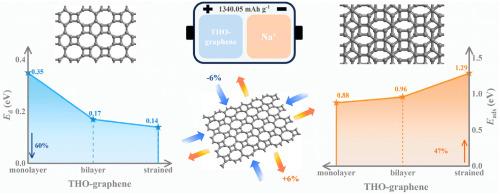Non-hexagonal tetra-hexa-octa-graphene for high-performance sodium-ion battery anodes: Effects of structural topology, mechanical strain, and van der Waals coupling
IF 7.9
2区 工程技术
Q1 CHEMISTRY, PHYSICAL
引用次数: 0
Abstract
Although numerous freestanding monolayer carbon allotropes have been proposed as anode candidates for sodium-ion batteries (SIBs), the influence of substrate-induced lattice strain and interfacial van der Waals interactions on their electrochemical performance remains largely unexplored. Using first-principles calculations, we predict a carbon allotrope, THO-graphene, composed of tetra-, hexa-, and octa-carbon rings, which exhibits an indirect bandgap semiconducting behavior. Monolayer THO-graphene demonstrates a high Na storage capacity (1340.05 mAh g−1), a low diffusion barrier (0.35 eV), and a low average open-circuit voltage (0.12 V), highlighting its potential as an anode material for SIBs. Remarkably, uniaxial strain ranging from −6 % to 6 % triggers a semiconductor-to-metal transition in THO-graphene, boosting its electrical conductivity while introducing anisotropic Na adsorption characteristics and reducing the diffusion barrier to an ultralow value of 0.14 eV. Furthermore, the inherently metallic bilayer THO-graphene enhances Na adsorption capability and preserves rapid diffusion kinetics.

高性能钠离子电池负极的非六方四六八元石墨烯:结构拓扑、机械应变和范德华耦合的影响
尽管许多独立的单层碳同素异体已经被提出作为钠离子电池(sib)的阳极候选材料,但衬底诱导的晶格应变和界面范德华相互作用对其电化学性能的影响在很大程度上仍未被探索。利用第一性原理计算,我们预测了一种由四碳环、六碳环和八碳环组成的碳同素异形体o -石墨烯,它具有间接带隙半导体行为。单层o -石墨烯表现出高钠存储容量(1340.05 mAh g−1),低扩散势垒(0.35 eV)和低平均开路电压(0.12 V),突出了其作为sib阳极材料的潜力。值得注意的是,- 6%至6%的单轴应变触发了o-石墨烯从半导体到金属的转变,提高了其导电性,同时引入了各向异性的Na吸附特性,并将扩散势垒降低到0.14 eV的超低值。此外,固有的金属双层氧化石墨烯增强了钠的吸附能力,并保持了快速的扩散动力学。
本文章由计算机程序翻译,如有差异,请以英文原文为准。
求助全文
约1分钟内获得全文
求助全文
来源期刊

Journal of Power Sources
工程技术-电化学
CiteScore
16.40
自引率
6.50%
发文量
1249
审稿时长
36 days
期刊介绍:
The Journal of Power Sources is a publication catering to researchers and technologists interested in various aspects of the science, technology, and applications of electrochemical power sources. It covers original research and reviews on primary and secondary batteries, fuel cells, supercapacitors, and photo-electrochemical cells.
Topics considered include the research, development and applications of nanomaterials and novel componentry for these devices. Examples of applications of these electrochemical power sources include:
• Portable electronics
• Electric and Hybrid Electric Vehicles
• Uninterruptible Power Supply (UPS) systems
• Storage of renewable energy
• Satellites and deep space probes
• Boats and ships, drones and aircrafts
• Wearable energy storage systems
 求助内容:
求助内容: 应助结果提醒方式:
应助结果提醒方式:


